IoT for Environmental Management and Security Governance: An Integrated Project in Taiwan
Abstract
:1. Introduction
2. Application of the IoT in Disaster Risk Management
2.1. Trends in IoT Development
2.1.1. Definition and Development of the IoT
2.1.2. Application of the IoT in the Environmental Field
2.2. Disaster Risk Management and Security Governance
2.2.1. Disaster Risk Management
2.2.2. Risk Communication and Security Governance
2.3. Civil IoT Taiwan
- establish IoT for the smart monitoring of environmental quality,
- improve the earthquake early warning (EEW) system for reducing loss,
- integrate the platform for disaster management (Integrated Platform on Information and Intelligence of Disaster), and
- improve the IoT for water resource management.
3. Methods
3.1. Research Scope
3.2. Social Return on Investment
4. Results
4.1. Assumptions, Data Collection, and Outcomes of Civil IoT Taiwan
4.2. SROI Evaluation and Analysis of Civil IoT Taiwan
5. Discussion
5.1. Limitations of SROI Analysis
5.2. Suggestions for the Second Phase of Civil IoT Taiwan
6. Conclusions
Author Contributions
Funding
Institutional Review Board Statement
Informed Consent Statement
Acknowledgments
Conflicts of Interest
Abbreviations
| AI | Artificial Intelligence |
| EEW | Earthquake early-warning |
| IoT | Internet of Things |
| PPP | Public-private partnership |
| SROI | Social return on investment |
References
- Dilley, M.; Chen, R.S.; Deichmann, U.; Lerner-Lam, A.L.; Arnold, M. Natural Disaster Hotspots: A Global Risk Analysis (Disaster Risk Management Series); World Bank: Washington, DC, USA, 2005; Available online: https://openknowledge.worldbank.org/handle/10986/7376 (accessed on 17 May 2015).
- Lee, H.-C.; Chang, S.-Y.; Chuang, M.-J.; Li, H.-C.; Lee, C.-S.; Li, C.-Y.; Su, J.-L.; Lin, L.-Y.; Chen, H. Study on Disaster Prevention Based on the Sendai Framework for Disaster Risk Reduction 2015–2030; Technical Report; National Science and Technology Center for Disaster Reduction: Taipei, Taiwan, 2017. (In Chinese) [Google Scholar]
- Lin, Y.-F. Solution-based spatial planning for disaster risk reduction and climate change adaptation in Taiwan. In Global Sustainability; Werlen, B., Ed.; Springer: Cham, Switzerland, 2015; pp. 227–237. [Google Scholar] [CrossRef]
- Chen, L.-C.; Li, W.-S. Learning from Taiwan’s Experience—Technology-Based Disaster Management. Prospect 2012, 8, 57–82. [Google Scholar]
- United Nations Office for Disaster Risk Reduction. Public Communication for Disaster Risk Reduction. Available online: https://www.undrr.org/publication/public-communication-disaster-risk-reduction (accessed on 2 September 2021).
- Civil IoT Taiwan. Available online: https://ci.taiwan.gov.tw/en (accessed on 14 June 2021).
- Ministry of Science and Technology, Environmental Protection Administration, Ministry of Transportation and Communications, Ministry of the Interior, and Ministry of Economic Affairs. Construction and Development of the Civil IoT Taiwan; the 1st phase of a medium-term development plan; Ministry of Science and Technology: Taipei, Taiwan, 2017; p. 175. (In Chinese) [Google Scholar]
- Environmental Protection Administration, Ministry of Transportation and Communications, Ministry of Science and Technology, Ministry of Economic Affairs, Ministry of the Interior, and Academia Sinica. Application and Industrial Innovation of the Civil IoT Taiwan; the 2nd phase of a medium-term development plan; Ministry of Science and Technology: Taipei, Taiwan, 2020; p. 133. (In Chinese) [Google Scholar]
- Berte, D.-R. Defining the IoT. Proc. Int. Conf. Bus. Excell. 2018, 12, 118–128. [Google Scholar] [CrossRef] [Green Version]
- Muntjir, M.; Rahul, M.; Alhumyani, H.A. An analysis of Internet of Things (IoT): Novel architectures, modern applications, security aspects and future scope with latest case studies. Int. J. Eng. Res. Technol. 2017, 6, 422–448. [Google Scholar]
- Patel, K.K.; Patel, S.M.; Scholar, P.-G.; Salazar, C. Internet of Things-IOT: Definition, characteristics, architecture, enabling technologies, application & future challenges. Int. J. Eng. Sci. Comput. 2016, 6, 6122–6131. [Google Scholar]
- Fracttal USA. The 9 Most Important Applications of the Internet of Things (IoT). 2019. Available online: https://www.fracttal.com/en/blog/the-9-most-important-applications-of-the-internet-of-things (accessed on 14 June 2021).
- Executive Yuan. White Paper on Disaster Management 2016; Annual Report; Executive Yuan: Taipei, Taiwan, 2017; p. 33. (In Chinese) [Google Scholar]
- Infanti, J.; Sixsmith, J.; Barry, M.M.; Núñez-Córdoba, J.; Oroviogoicoechea-Ortega, C.; Guillén-Grima, F. A Literature Review on Effective Risk Communication for the Prevention and Control of Communicable Diseases in Europe; ECDC: Stockholm, Sweden, 2013. [Google Scholar]
- Shaw, R.; Takeuchi, Y.; Matsuura, S.; Saito, K. Risk Communication; Knowledge Note 5-3 of Cluster 5: Hazard and Risk Information and Decision Making; World Bank: Washington, DC, USA, 2011. [Google Scholar]
- The United Nations Office for Disaster Risk Reduction. Disaster Risk Reduction. Available online: https://www.undrr.org/terminology/disaster-risk-management (accessed on 25 August 2021).
- Nicholls, J.; Lawlor, E.; Neitzert, E.; Goodspeed, T. A Guide to Social Return on Investment. Available online: https://www.fi-compass.eu/publication/other-resources/guide-social-return-investment (accessed on 17 June 2021).
- The New Economics Foundation Consulting. SSE—Beatrice SROI Framework; New Economics Foundation: London, UK, 2013; p. 20. [Google Scholar]
- Executive Yuan. White Paper on Disaster Management 2017; Annual Report; Executive Yuan: Taipei, Taiwan, 2018; p. 33. (In Chinese) [Google Scholar]
- Executive Yuan. White Paper on Disaster Management 2018; Annual Report; Executive Yuan: Taipei, Taiwan, 2019; p. 33. (In Chinese) [Google Scholar]
- Executive Yuan. White Paper on Disaster Management 2019; Annual Report; Executive Yuan: Taipei, Taiwan, 2020; p. 33. (In Chinese) [Google Scholar]
- National Fire Agency. Statistics for Natural Disaster Losses (1958–2020). Available online: https://www.nfa.gov.tw/cht/index.php?code=list&ids=233 (accessed on 28 June 2021).
- Council of Agriculture. Agricultural Statistics Yearbook 2016; Annual Report; Concil of Agriculture: Taipei, Taiwan, 2017. [Google Scholar]
- Council of Agriculture. Agricultural Statistics Yearbook 2017; Annual Report; Concil of Agriculture: Taipei, Taiwan, 2018. [Google Scholar]
- Council of Agriculture. Agricultural Statistics Yearbook 2018; Annual Report; Concil of Agriculture: Taipei, Taiwan, 2019. [Google Scholar]
- Council of Agriculture. Agricultural Statistics Yearbook 2019; Annual Report; Concil of Agriculture: Taipei, Taiwan, 2020. [Google Scholar]
- Council of Agriculture (COA). Agricultural Statistics Yearbook 2020; Annual Report; Concil of Agriculture: Taipei, Taiwan, 2021. [Google Scholar]
- Ministry of Science and Technology, Environmental Protection Administration, Ministry of Transportation and Communications, Ministry of the Interior, and Ministry of Economic Affairs. Construction and Development of Civil IoT Taiwan: Progress and Performance Report for 2020; Annual report; Ministry of Science and Technology: Taipei, Taiwan, 2021; p. 42. (In Chinese) [Google Scholar]
- Integrated Platform on Information and Intelligence of Disaster. Available online: https://eocdss.ncdr.nat.gov.tw/web/ (accessed on 14 June 2021).
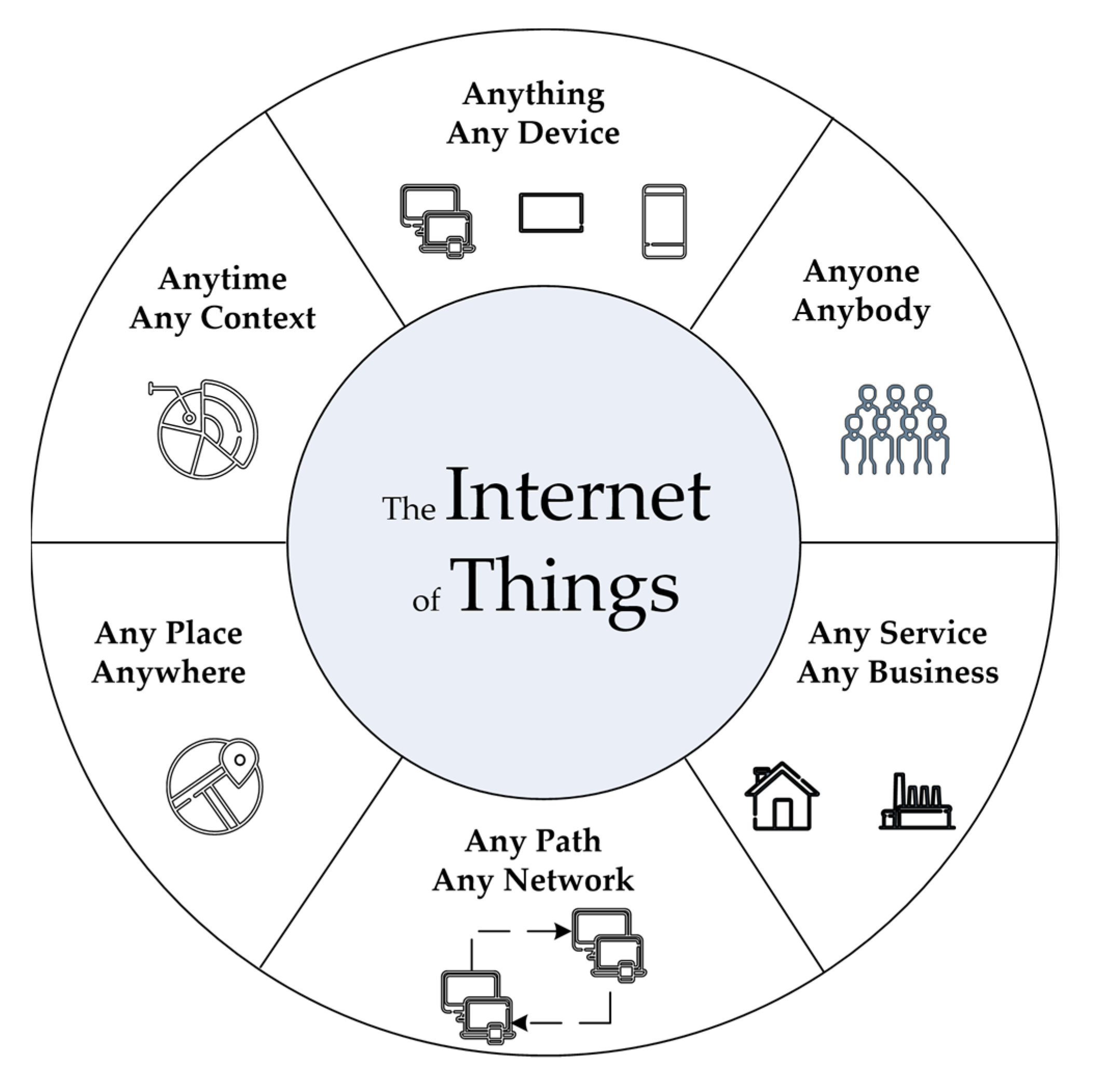
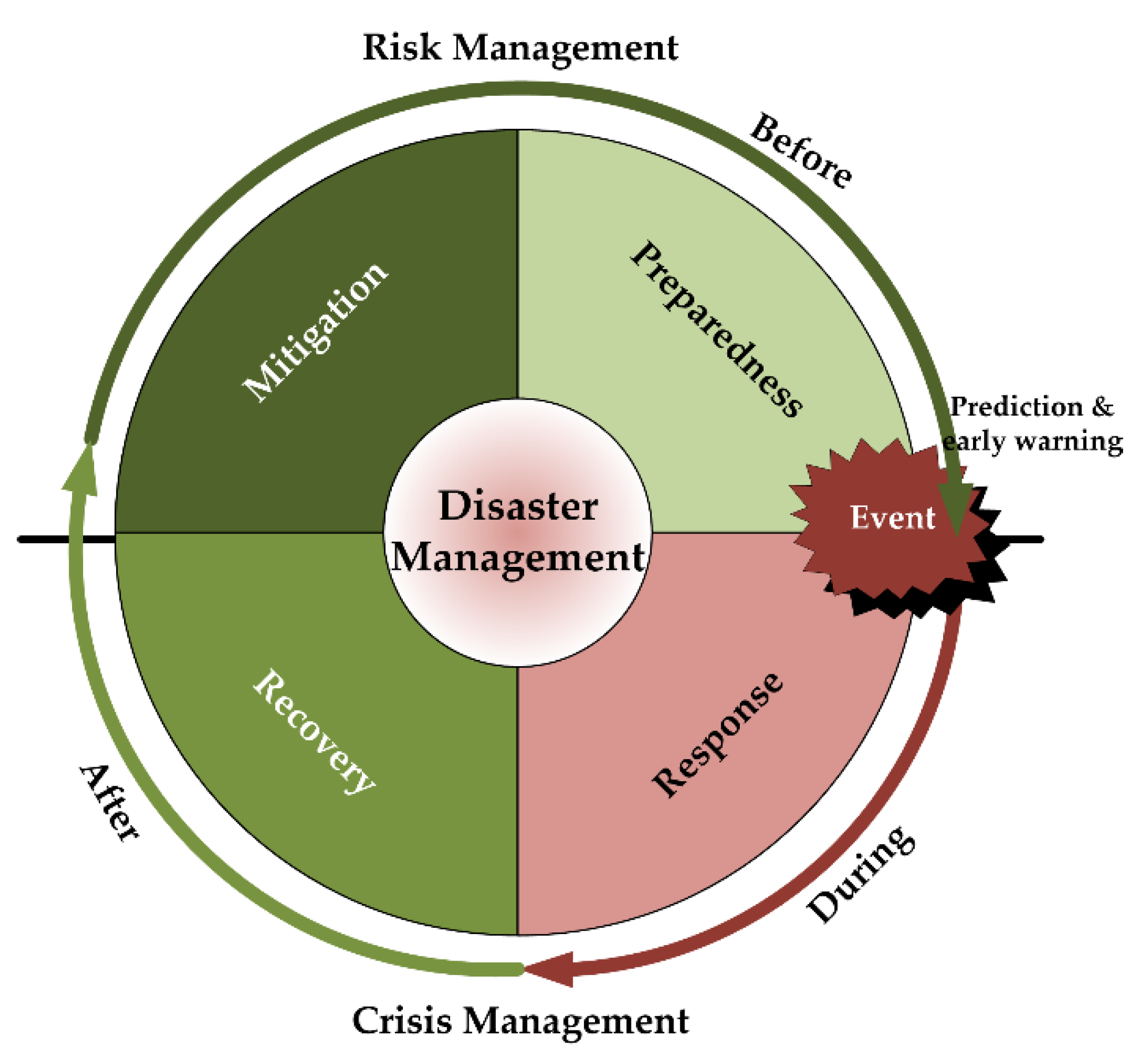
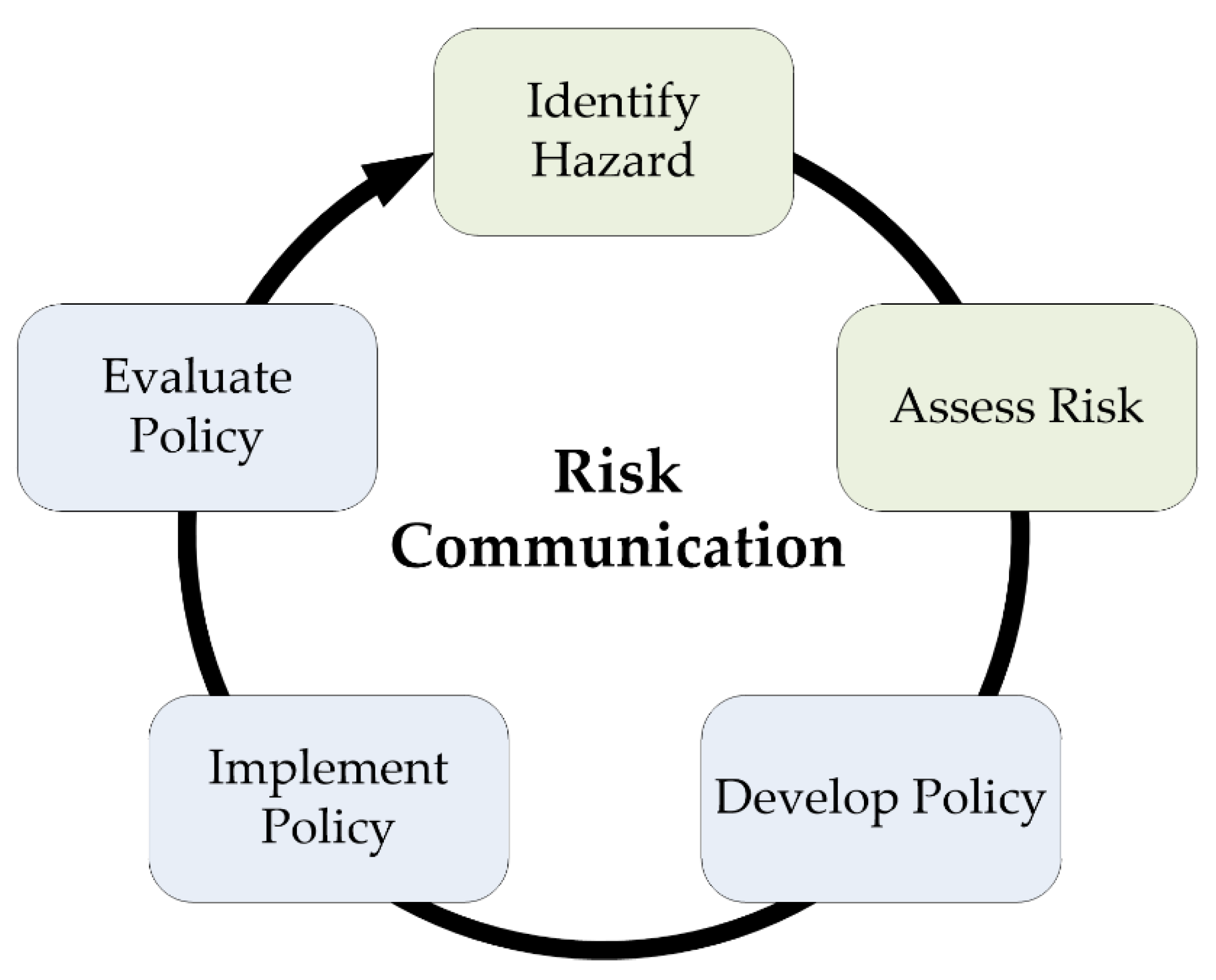
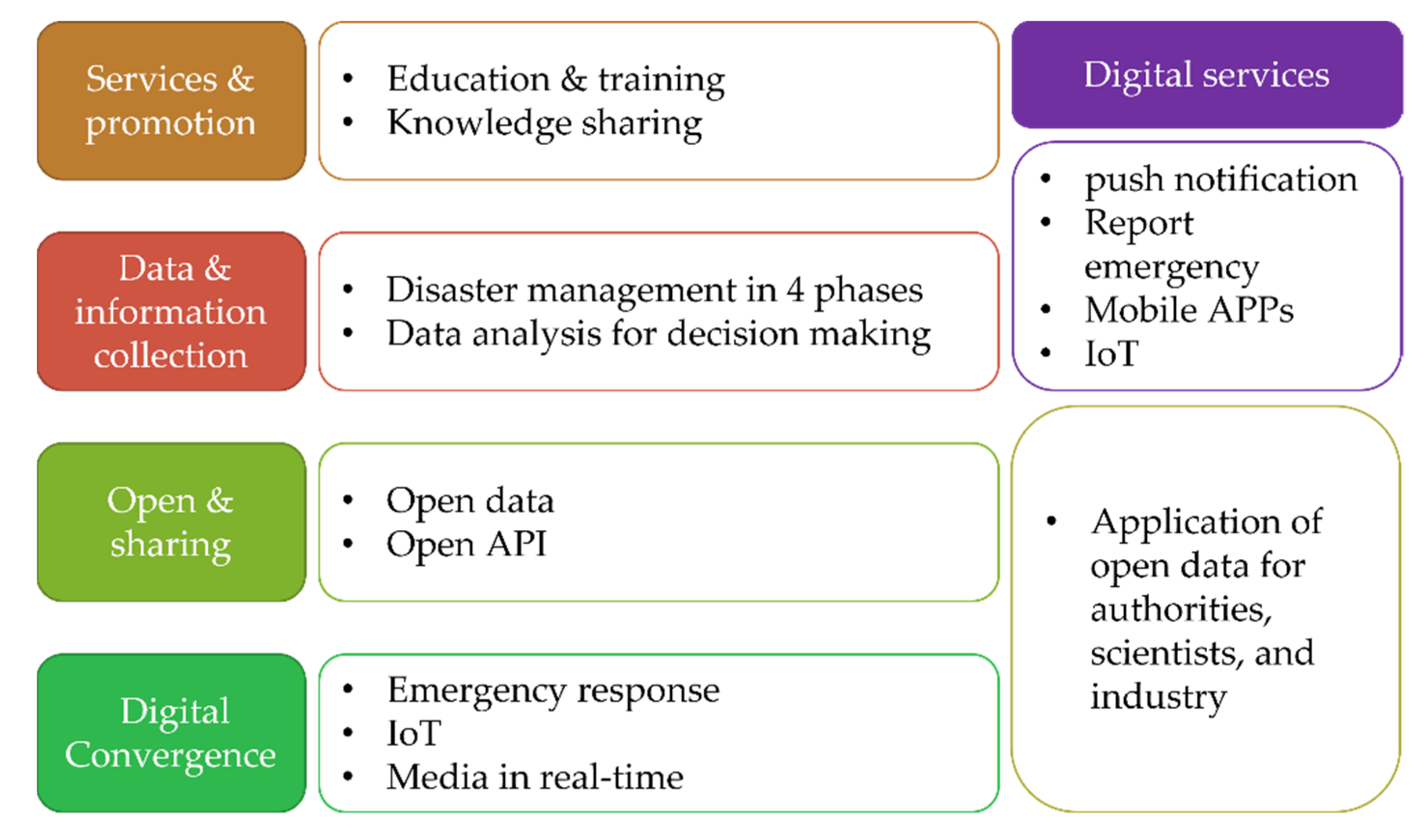
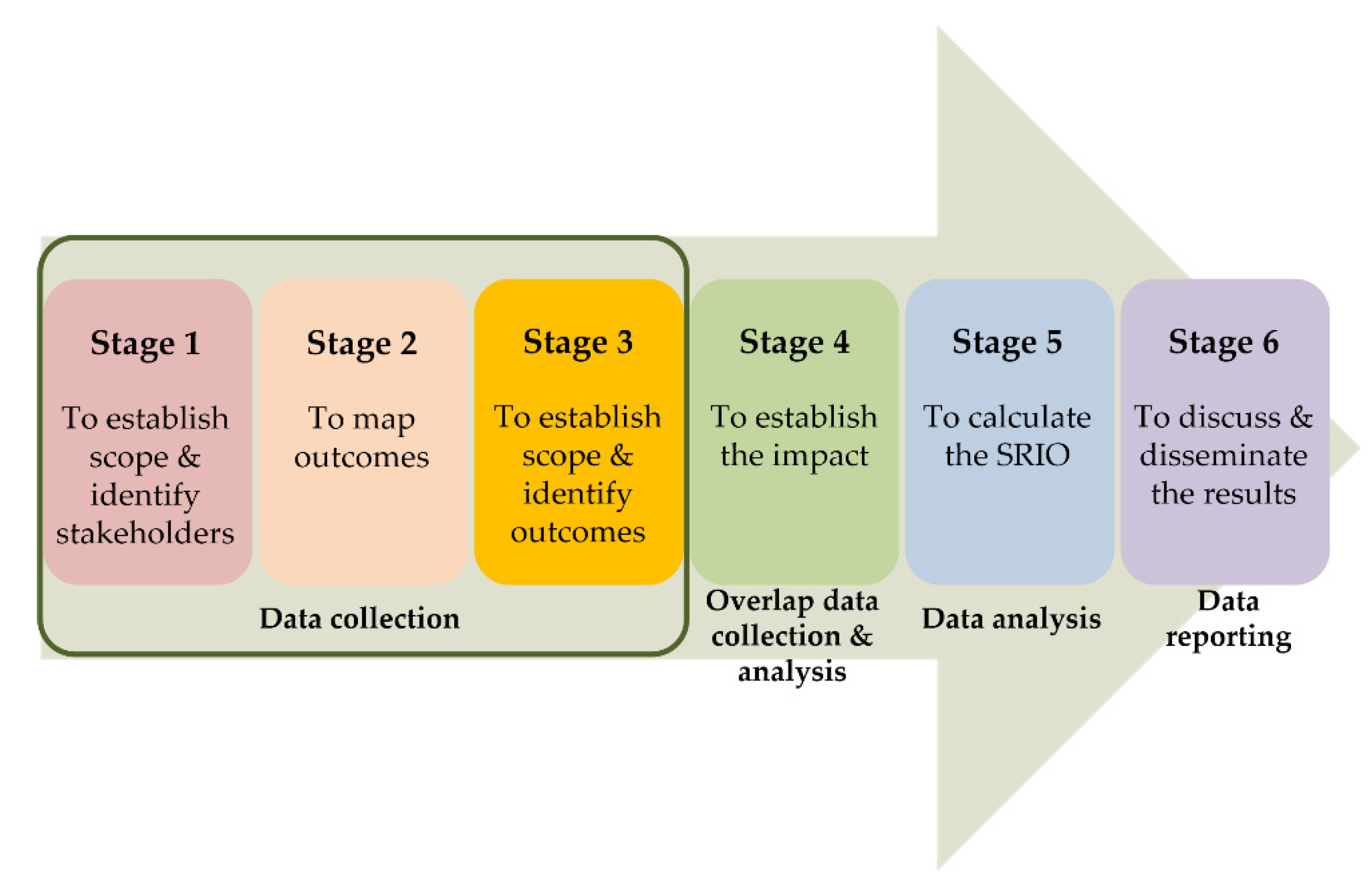
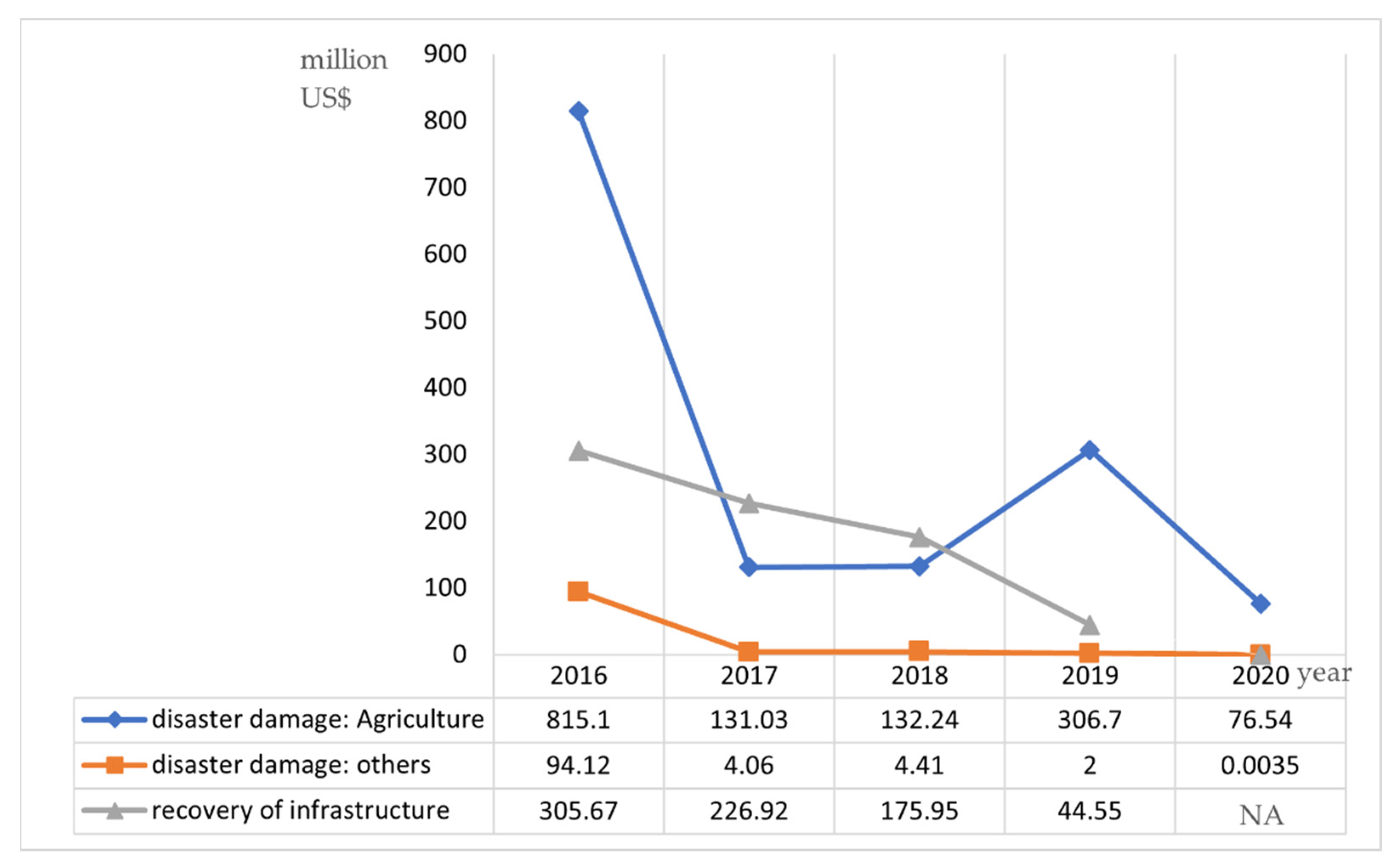
| Subprojects a | Functions |
|---|---|
| Air quality | A. Develop air quality sensors B. Deploy air quality sensors across the island C. Auxiliary environmental inspection D. Prompt private-sector development of air quality sensing |
| Earthquake | A. Deliver a submarine cable seismic and tsunami observation system B. Develop a hybrid earthquake early warning platform C. Encourage private-sector applications and developments in disaster preparedness |
| Water Management | A. Establish a common application platform for disaster prevention B. Establish a public alert open data platform C. Provide real-time and historical Civil IoT sensing data by the Open Geospatial Consortium SensorThings Application programming interface |
| Disaster prevention and response | A. Develop and deploy a multiple water source monitoring system B. Apply an irrigation water allocation dynamic analysis management platform C. Provide flood warnings D. Develop a value-added application of the sewerage system management cloud |
| Questions a | Description | Data Collection for SROI |
|---|---|---|
| Who changes? (Identify stakeholders) | Involving all people, organizations, and environments significantly affected | 1. Authorities (decision-makers) 2. Public 3. Industry |
| How do they change? (Understand what changes) | Focusing on the important changes both positive and negative | 1. Reduced disaster damage/loss 2. Disaster preparedness and mitigation 3. Risk communication |
| How do you know? (Value the things that matter) | Gathering evidence to go beyond individual opinion. Rating the important outcomes by valuing economic, social, and environmental benefits and costs | 1. Infrastructure and platform for risk management 2. Data collection and analysis 3. Information delivery services 4. Additional industrial investments |
| How much is you? | Accounting for other influences that might have changed the situation for the better or worse | 1. Thought changed 2. Preparedness 3. Reduced loss and cost saved |
| How important are the changes? (Verify the result) | Understanding the relative value of the outcomes to all affected stakeholders | 1. Loss reduced 2. Cost saved 3. Lives saved |
| Year | Disaster Events a | Person | House/Building | |||||
|---|---|---|---|---|---|---|---|---|
| Dead | Missing | Heavily Wounded | Lightly Wounded | Rescued Victims | All Destruction | Half Destruction | ||
| 2016 | 1 earthquake, 7 flood events, 5 typhoons | 130 | 0 | 88 | 1515 | 2209 | 142 | 175 |
| 2017 | 1 earthquake, 2 droughts, 4 flood events, 4 typhoons | 5 | 2 | 10 | 138 | 485 | 0 | 7 |
| 2018 | 1 earthquake, 1 drought, 9 flood events, 2 typhoons | 24 | 1 | 22 | 326 | 1956 | 4 | 0 |
| 2019 | 2 earthquakes, 1 drought, 11 flood events, 3 typhoons | 5 | 1 | 1 | 71 | 114 | 0 | 4 |
| 2020 | 3 droughts, 6 flood events, 5 typhoons | 1 | 1 | 0 | 5 | 3 | 0 | 0 |
| Stakeholders | Items | Values a |
|---|---|---|
| Authorities | Infrastructure for early warning and monitoring | 93.05 |
| Platform for integrated disaster preparedness and mitigation | 50.35 | |
| Water management | 29.25 | |
| Industry of disaster prevention | Infrastructure for early warning and monitoring | 32.66 |
| Platform for integrated disaster preparedness and mitigation | 13.93 | |
| Water management | 3.77 | |
| Public | Time and personal equipment (e.g., PC, mobile phones, etc.) to obtain information | 0 b |
| Sum | 223.01 | |
| Aspects | Social | Economic | Environmental |
|---|---|---|---|
| Outputs a | 1. Shortened EEW of earthquakes by 20 s 2. 20,000 views of environmental education videos 3. Training for decision-makers 36 times with 1451 people 4. Pushing notifications by 570,000 times with 2 billion datasets and 260,000 interface data (2017 to 2020) | 1. 14 industrial investments 2. provide vacancies | 1. Setting monitoring, evaluation, and storage systems in 263 districts, 111 industrial parks, and platforms 2. 97 EEW stations 3. 23 early warning information items |
| Outcomes | Impacts | Amount a |
|---|---|---|
| Social aspect: 210.34 | ||
| Shortened EEW of earthquakes by 20 s | Reduced disaster damage and loss and saved lives | 18.67 |
| 20,000 views of environmental education videos | Reduced disaster damage and loss risk awareness | N/A |
| Training for decision-makers 36 times with 1451 people | Reduced disaster damage and loss | N/A |
| Pushing notification 570,000 times | Saved amount of reserve fund | 191.57 |
| Economic aspect: 20.67 | ||
| Industrial investments | Increased orders | 18.67 |
| Provide job opportunities | Increased capacities | 2 |
| Environmental aspect: 2.99 | ||
| Setting monitoring, evaluation, and storage system in 263 districts, 111 industrial parks, and platforms | Reduced disaster damage and loss Saved amount of reserve fund | 2.99 |
| 23 early warning information items from by 97 EEW stations | Reduced disaster damage and losses | N/A |
| Sum (not discounted) | 234 | |
| Items | Amount | Items | Amount |
|---|---|---|---|
| Input | Attribution | ||
| Infrastructure for early warning and monitoring | 125.71 | Disaster Prevention and Protection Project | 13.30 |
| Platform for integrated disaster preparedness and mitigation | 64.27 | Impact | |
| Social aspect | 210.34 | ||
| Economic aspect | 20.67 | ||
| Water management | 33.02 | Environmental aspect | 2.99 |
| Sum (million US$) | 223.01 | Sum (million US$) | 234 |
| SROI Ratio a = 234/(223.01−13.3) = 1.12 | |||
Publisher’s Note: MDPI stays neutral with regard to jurisdictional claims in published maps and institutional affiliations. |
© 2021 by the authors. Licensee MDPI, Basel, Switzerland. This article is an open access article distributed under the terms and conditions of the Creative Commons Attribution (CC BY) license (https://creativecommons.org/licenses/by/4.0/).
Share and Cite
Lin, Y.-F.; Chang, T.-Y.; Su, W.-R.; Shang, R.-K. IoT for Environmental Management and Security Governance: An Integrated Project in Taiwan. Sustainability 2022, 14, 217. https://doi.org/10.3390/su14010217
Lin Y-F, Chang T-Y, Su W-R, Shang R-K. IoT for Environmental Management and Security Governance: An Integrated Project in Taiwan. Sustainability. 2022; 14(1):217. https://doi.org/10.3390/su14010217
Chicago/Turabian StyleLin, Yu-Fang, Tzu-Yin Chang, Wen-Ray Su, and Rong-Kang Shang. 2022. "IoT for Environmental Management and Security Governance: An Integrated Project in Taiwan" Sustainability 14, no. 1: 217. https://doi.org/10.3390/su14010217
APA StyleLin, Y.-F., Chang, T.-Y., Su, W.-R., & Shang, R.-K. (2022). IoT for Environmental Management and Security Governance: An Integrated Project in Taiwan. Sustainability, 14(1), 217. https://doi.org/10.3390/su14010217





